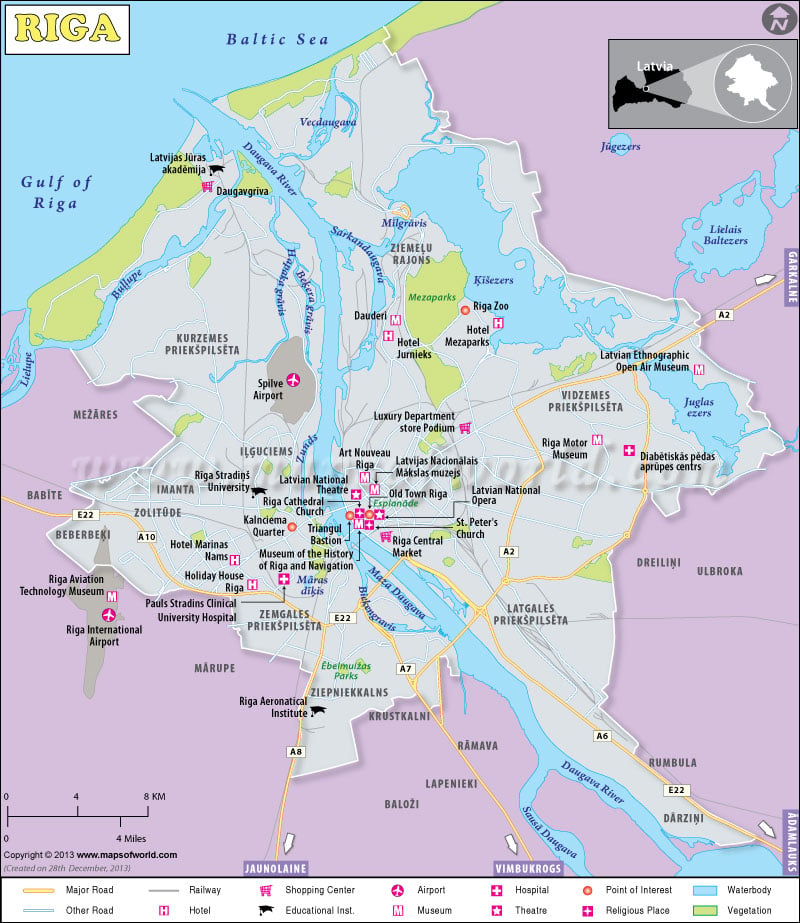Riga City
Riga is the capital of Latvia and home to more than a third of the country’s population. One of the key financial and economic centers of the 3 Baltic States, it is a major urban hub but with half of its area decked with old world architecture and historical monuments. Considered as one of the most attractive cities in the world, it is 2014’s European Capital of Culture, as designated by the European Union.
Geography
Riga has a significant central geographical position in the Baltic States. Located by the river Daugava, the city is divided into 2 parts – one of which is the Old Town and the other, the urban area.
How to Reach (Transport)
- By Plane – Flights to and from domestic and international destinations are serviced at the Riga International Airport, which is the largest one in all the Baltic States. It is conveniently located only 10km southwest from the city center.
- By Bus – international bus connections to several European cities can be availed from Riga.
- By Ferry/Boat – a daily ferry service to Stockholm and back is available with the Tallink, as well at boat rides in May to September to the beach area of Jurmula.
- By Train – The Latvian Railways offer domestic trips as well as international destinations to Russia, Belarus, Estonia, Moscow, and several other cities. The local Latvian Railroad are electronic trains that bring passengers to and from the city’s suburbs and nearby towns.
- By Trams (streetcars) – the Tram is the second fastest mode of transportation next to the train – they enjoy right of way in traffic and their small sizes make it easier for operators to maneuver in narrow spaces on the streets.
- By Bike – using a bicycle to navigate the streets of Riga is popular with the large number of bike stands available across the city.
When to Visit
The most popular times to visit Riga is in the summer from June to August. The months of April to September are the favorite times of tourists to visit the city and this usually means the sites are clogged with crowds. January and February are the best months for winter sports in the city.
Culture (fairs and festivals) and Traditions
- The Latvian Midsummer Festival – Riga’s favorite holiday, the Midsummer Festival also known as the Janis and Ligo Festival is a worldwide pagan tradition and a celebration of the birthday of St. John. Residents flock to the woods to gather around a bonfire, with feasts of drinking and dancing from day to night until the wee hours of the morning.
- The Riga Festival – a gathering of local, national, and international classical music acts, the performances can be watched inside the city’s most prominent historical venues such as the St. Peter’s Church and the Riga Cathedral.
- Re Re Riga – a festival that started in 2013, it is a celebration of street art and world music. The biggest international festival of its kind in the Baltic States, performances and shows of every kind of street art imaginable can be seen in the city.
- The Latviabeerfest – held every year at the Vermares Garden, it is the Baltic’s biggest beer festival, with an emphasis on traditions and the showcase of Latvian beer production.
Points of Interest (Places to Visit)
- Riga’s Old Town – a small but culturally rich medieval town, the structures are incredibly well-preserved despite going through two World Wars. You can find old world charm along its stoned streets, its magnificent churches, and its inner area of 13th-18th century structures.
- Black Head House – one of Riga’s most iconic buildings, it stands dominantly in the city with its Gothic architecture and Dutch Renaissance facade.
- Alberta Iela – this street boasts of the largest number of Art Nouveau buildings. Considered as one of the most beautiful streets in Europe, it has a large number of well-preserved apartment buildings that make the best examples of this architectural style.
- Riga Central Market – it was once one of the biggest markets in Europe but only 4 of the 5 pavilions are being used today. It’s a daily market of Riga’s local produce that range from meats to fish, vegetables, fruits, handicrafts, and dairy. A bustling atmosphere set in old airship hangars, it’s the best place to witness Riga’s rich culture and identity.
Accommodation
Plenty of accommodation choices are available in Riga for every type of traveler. Luxury hotels are available for those who want to splurge while midrange hotels are the most preferred. Budget places to stay such as dorms and hostels are also available, as well as a campsite for backpackers.
